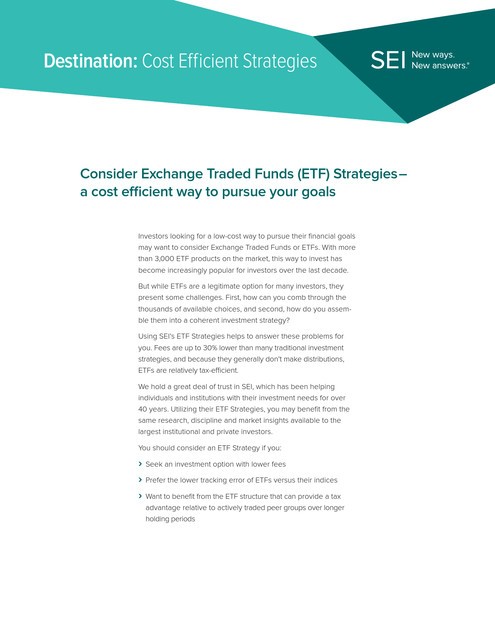ETF Strategies
Post on: 1 Май, 2015 No Comment

ETFs offer an ever-increasing array of investing opportunities — they can be optioned, shorted, hedged, and bundled. Still, most individual investors should stick to a few simple ETF strategies.
By Motley Fool Staff | More Articles
September 14, 2009 | Comments (1)
Sick of hearing about the fun everyone else is having with Exchange-Traded Funds? Don’t worry: Your invitation is in the mail.
ETFs are an extremely flexible investment vehicle: They can be optioned, shorted, hedged, bundled, and more. ETFs capture a variety of general stock market or economic trends without the risk of single-stock exposure, and they’re designed for diversity — peddled for less than what most like-minded traditional mutual funds charge.
ETFs may just be the wave of the future for most individual investors. But if you’re investing for the long-term — whether novice or near-expert — the best ETF strategies are probably the simplest ones: filling asset allocation gaps and replacing higher-fee mutual funds.
If you want to get fancier than that, ETFs can likely accommodate more advanced investing tactics described below. But we recommend some of the following strategies only with great caution. As the Bard has said, Here there be dragons.
Placing sector bets
Many investors — and most of us here at The Motley Fool who proudly answer to that label — like to make bets on individual stocks. Others prefer to follow the direction of entire sectors or geographic regions. If this is you, then consider ETFs. Some international ETFs give you exposure to stocks or entire industries that you cannot buy on the U.S. exchanges. And you needn’t only make feel-good positive bets: ETFs can be sold short, even on a downtick. (Thanks to a regulation many feel is out-of-date, regular stocks cannot be shorted if the last trade price is lower than the next-to-last trade price.)
Betting on bonds
ETFs let you make bets on just about anything tracked by an index, and 007s are no exception. Options range from an ETF tracking the ultra-broad Lehman Aggregate Bond index to funds focusing on corporate-bond indices, inflation-protected Treasuries, or specific segments of the yield curve.
This yield curve business offers enticement to both guru and neophyte alike. A professional might use an ETF to exploit an anticipated movement in, say, the yields of 7- to 10-year Treasuries. An individual investor might combine bond ETFs of varying duration (there aren’t too many yet) to give broad-based exposure similar in effect to bond laddering (a strategy based on maintaining a portfolio of individual bonds staggered across a wide range of maturities).
Parking cash
If you’ve got permanent cash in your portfolio, or at least cash that will be sitting around for a little while, you could garage it in short-duration bond ETFs instead of money market funds. These investments often pay double or triple money-market yields. However, don’t blow your gains on brokerage fees. Although some money market funds make investors pay early withdrawal penalties, brokerage fees to sell your bond ETFs could run even higher. But if you’re just looking for something less risky than stocks yet still fairly secure and are willing to commit for a while, you might appreciate their higher returns.

Avoiding the wash-sale rule
A common tax-reduction method is to sell money-losing stocks and use the losses to offset taxable gains from money-earning positions. (See our Tax Center for more investor tax issues.) One tax no-no, however, is called a wash sale, wherein you simply sell something that has lost money — harvesting the loss to offset taxable gains you’ve got elsewhere — and then buy it right back. It is defined as not only the exact security you just sold, but anything substantially identical as well. Fortunately, the plethora of ETFs has given investors options that may be similar in spirit, but not substantially identical, to the investments (typically other ETFs or mutual funds) they sold to harvest losses.
Pairs trading
Pairs trading is a hedge fund favorite and ETFs have made it easier. Say you believe a given stock will outperform its sector but aren’t confident on the direction that that sector will go next. To capture that stock-vs.-sector performance differential (which will probably be small), you buy the stock and short its sector ETF. Or, if you think a company is much worse than its peers, you short it and go long the ETF. This is best attempted by those with an intimate knowledge of specific companies and industries. The meager returns of this strategy are tempered by the fact that it can be done in any market climate. And the strategy is far from bulletproof: Both the sector and the company could move in exact opposite directions of what you assume, compounding your loss.
Creating an ETF-only portfolio
If your goal is simply to have a mix of assets, ETFs let you do this simply and cheaply. Why sweat through finding a good tech company just because your broker says you need more tech? No need to trust anyone’s stock picks either. Of course, you’ll miss out on the stock-specific gains, but you’ll also miss out on the stock-specific losses. For many investors, that’s a worthwhile tradeoff.
A final caution
ETF strategies are plentiful, but so are the pitfalls. Most of the downside tends to be self-induced (e.g. excessive trading). But a more painful blow can be dealt by the misguided purchase of an ETF. Read on for ways to safely manage ETFs in your portfolio.














